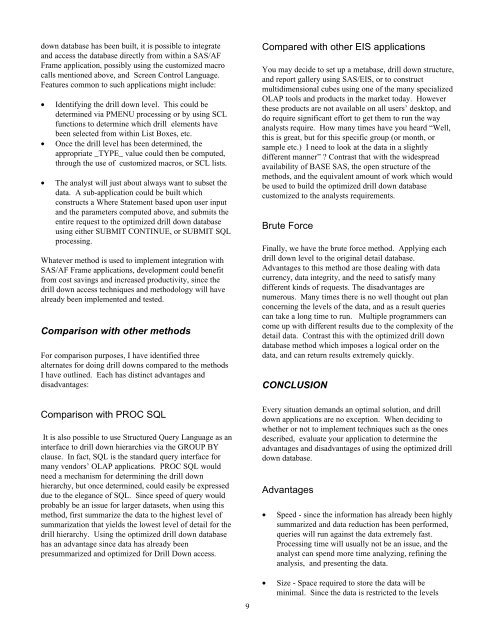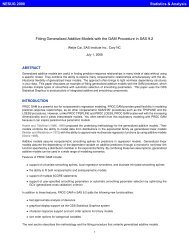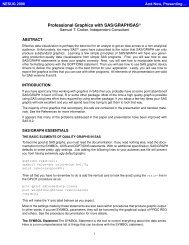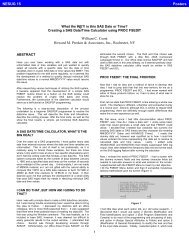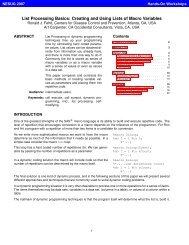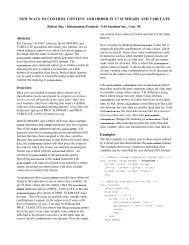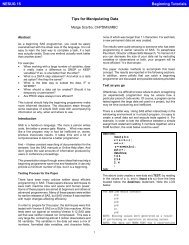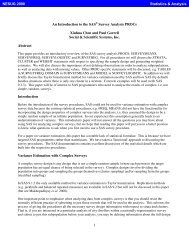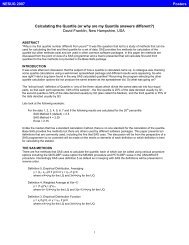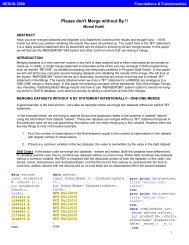Drill Down Till You Drop: OLAP Without Windows - NESUG
Drill Down Till You Drop: OLAP Without Windows - NESUG
Drill Down Till You Drop: OLAP Without Windows - NESUG
- No tags were found...
Create successful ePaper yourself
Turn your PDF publications into a flip-book with our unique Google optimized e-Paper software.
down database has been built, it is possible to integrateand access the database directly from within a SAS/AFFrame application, possibly using the customized macrocalls mentioned above, and Screen Control Language.Features common to such applications might include:• Identifying the drill down level. This could bedetermined via PMENU processing or by using SCLfunctions to determine which drill elements havebeen selected from within List Boxes, etc.• Once the drill level has been determined, theappropriate _TYPE_ value could then be computed,through the use of customized macros, or SCL lists.• The analyst will just about always want to subset thedata. A sub-application could be built whichconstructs a Where Statement based upon user inputand the parameters computed above, and submits theentire request to the optimized drill down databaseusing either SUBMIT CONTINUE, or SUBMIT SQLprocessing.Whatever method is used to implement integration withSAS/AF Frame applications, development could benefitfrom cost savings and increased productivity, since thedrill down access techniques and methodology will havealready been implemented and tested.Comparison with other methodsFor comparison purposes, I have identified threealternates for doing drill downs compared to the methodsI have outlined. Each has distinct advantages anddisadvantages:Comparison with PROC SQLIt is also possible to use Structured Query Language as aninterface to drill down hierarchies via the GROUP BYclause. In fact, SQL is the standard query interface formany vendors’ <strong>OLAP</strong> applications. PROC SQL wouldneed a mechanism for determining the drill downhierarchy, but once determined, could easily be expresseddue to the elegance of SQL. Since speed of query wouldprobably be an issue for larger datasets, when using thismethod, first summarize the data to the highest level ofsummarization that yields the lowest level of detail for thedrill hierarchy. Using the optimized drill down databasehas an advantage since data has already beenpresummarized and optimized for <strong>Drill</strong> <strong>Down</strong> access.Compared with other EIS applications<strong>You</strong> may decide to set up a metabase, drill down structure,and report gallery using SAS/EIS, or to constructmultidimensional cubes using one of the many specialized<strong>OLAP</strong> tools and products in the market today. Howeverthese products are not available on all users’ desktop, anddo require significant effort to get them to run the wayanalysts require. How many times have you heard “Well,this is great, but for this specific group (or month, orsample etc.) I need to look at the data in a slightlydifferent manner” ? Contrast that with the widespreadavailability of BASE SAS, the open structure of themethods, and the equivalent amount of work which wouldbe used to build the optimized drill down databasecustomized to the analysts requirements.Brute ForceFinally, we have the brute force method. Applying eachdrill down level to the original detail database.Advantages to this method are those dealing with datacurrency, data integrity, and the need to satisfy manydifferent kinds of requests. The disadvantages arenumerous. Many times there is no well thought out planconcerning the levels of the data, and as a result queriescan take a long time to run. Multiple programmers cancome up with different results due to the complexity of thedetail data. Contrast this with the optimized drill downdatabase method which imposes a logical order on thedata, and can return results extremely quickly.CONCLUSIONEvery situation demands an optimal solution, and drilldown applications are no exception. When deciding towhether or not to implement techniques such as the onesdescribed, evaluate your application to determine theadvantages and disadvantages of using the optimized drilldown database.Advantages• Speed - since the information has already been highlysummarized and data reduction has been performed,queries will run against the data extremely fast.Processing time will usually not be an issue, and theanalyst can spend more time analyzing, refining theanalysis, and presenting the data.9• Size - Space required to store the data will beminimal. Since the data is restricted to the levels


